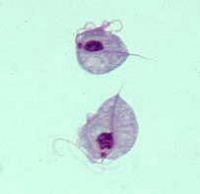Difference between revisions of "Trichomonas gallinae"
| (16 intermediate revisions by 3 users not shown) | |||
| Line 1: | Line 1: | ||
| − | + | Also Known As — [[Trichomonosis - Birds | '''''Avian Trichomonosis''''']] — '''''Avian Trichomoniasis''''' — '''''Trichomonosis''''' — '''''[[Trichomonosis - Birds]]''''' | |
| + | |||
{{Taxobox | {{Taxobox | ||
|name = Trichomonas gallinae | |name = Trichomonas gallinae | ||
| Line 15: | Line 16: | ||
|sub-family = | |sub-family = | ||
|genus = Trichomonas | |genus = Trichomonas | ||
| − | |species = | + | |species = Trichomonas gallinae |
}} | }} | ||
==Introduction== | ==Introduction== | ||
| − | [[File: | + | [[File:Trichomonas.JPG|thumb|200px|right|Trichomonas sp with Giemsa staining. Note the posterior flagellae and undulating membrane. (Source - Wikimedia Commons)]] |
| − | + | Trichomonas gallinae is the [[Protozoa | '''protozoal''']] pathogen responsible for [[Trichomonosis - Birds | '''Avian Trichomonosis''']]. | |
| − | The parasite is identifiable microscopically by its four '''anterior flagellae''' and well developed '''undulating membrane''' on one side | + | The parasite is identifiable microscopically by its four '''anterior flagellae''' and well developed '''undulating membrane''' on one side. |
| − | The ''' | + | ''T. gallinae'' has no posterior flagellum. |
| + | Its body is divided by an ''axostyle''. | ||
| + | |||
| + | The '''ellipsoid nucleus''' of the parasite is usually found in the posterior aspect of the organism. | ||
''T. gallinae'' requires sugars, starch and glycogen from host cells to survive and replicate. | ''T. gallinae'' requires sugars, starch and glycogen from host cells to survive and replicate. | ||
==Transmission== | ==Transmission== | ||
| − | ''Trichomonas gallinae'' is present '''worldwide''' in wild birds particularly the '''pigeon''' and other Columbids | + | ''Trichomonas gallinae'' is present '''worldwide''' in wild birds particularly the '''pigeon''' and other Columbids. |
| − | Transmission between pigeons occurs orally during feeding and mating behaviour | + | Transmission between pigeons occurs orally during feeding and mating behaviour. |
Transmission to domestic chickens and turkeys is achieved through contaminated '''water troughs''' that have been visited by wild birds. | Transmission to domestic chickens and turkeys is achieved through contaminated '''water troughs''' that have been visited by wild birds. | ||
==Disease== | ==Disease== | ||
| − | + | T gallinae causes '''yellow, necrotic lesions''' and plaques in the gastrointestinal tract of birds, particularly in the [[Crop - Anatomy and Physiology | crop]] and [[Oesophagus | oesophagus]]. | |
| − | + | ||
| + | '''[[Anaemia]]''' is caused when the parasite binds to [[Erythrocytes | erythrocytes]] and induces phagocytosis, causing '''haemolysis'''. | ||
| − | + | ==Control== | |
| − | + | Prevention of disease relies upon prevention of wild birds’ access to domestic birds and their water supplies. | |
| − | | | + | Relevant Links – [[Trichomonosis - Birds | Avian Trichomonosis]], [[Trichomonosis - Cattle | Bovine Trichomonosis]] |
| − | |||
==References== | ==References== | ||
<references/> | <references/> | ||
| − | + | Animal Health & Production Compendium, Trichomonas gallinae datasheet, accessed 02/06/2011 @ http://www.cabi.org/ahpc/ | |
| − | |||
| − | |||
| − | |||
| − | |||
| − | |||
| − | |||
| − | |||
| − | |||
| − | |||
| − | [[Category: | + | [[Category:To Do - Steph]] |
| − | [[Category:CABI | + | [[Category:To Do - CABI Review]] |
Revision as of 11:45, 3 June 2011
Also Known As — Avian Trichomonosis — Avian Trichomoniasis — Trichomonosis — Trichomonosis - Birds
| Trichomonas gallinae | |
|---|---|
| Kingdom | Protista |
| Phylum | Protozoa |
| Order | Trichomonadida |
| Family | Trichomonadidae |
| Genus | Trichomonas |
| Species | Trichomonas gallinae |
Introduction
Trichomonas gallinae is the protozoal pathogen responsible for Avian Trichomonosis.
The parasite is identifiable microscopically by its four anterior flagellae and well developed undulating membrane on one side.
T. gallinae has no posterior flagellum. Its body is divided by an axostyle.
The ellipsoid nucleus of the parasite is usually found in the posterior aspect of the organism.
T. gallinae requires sugars, starch and glycogen from host cells to survive and replicate.
Transmission
Trichomonas gallinae is present worldwide in wild birds particularly the pigeon and other Columbids.
Transmission between pigeons occurs orally during feeding and mating behaviour.
Transmission to domestic chickens and turkeys is achieved through contaminated water troughs that have been visited by wild birds.
Disease
T gallinae causes yellow, necrotic lesions and plaques in the gastrointestinal tract of birds, particularly in the crop and oesophagus.
Anaemia is caused when the parasite binds to erythrocytes and induces phagocytosis, causing haemolysis.
Control
Prevention of disease relies upon prevention of wild birds’ access to domestic birds and their water supplies.
Relevant Links – Avian Trichomonosis, Bovine Trichomonosis
References
Animal Health & Production Compendium, Trichomonas gallinae datasheet, accessed 02/06/2011 @ http://www.cabi.org/ahpc/
